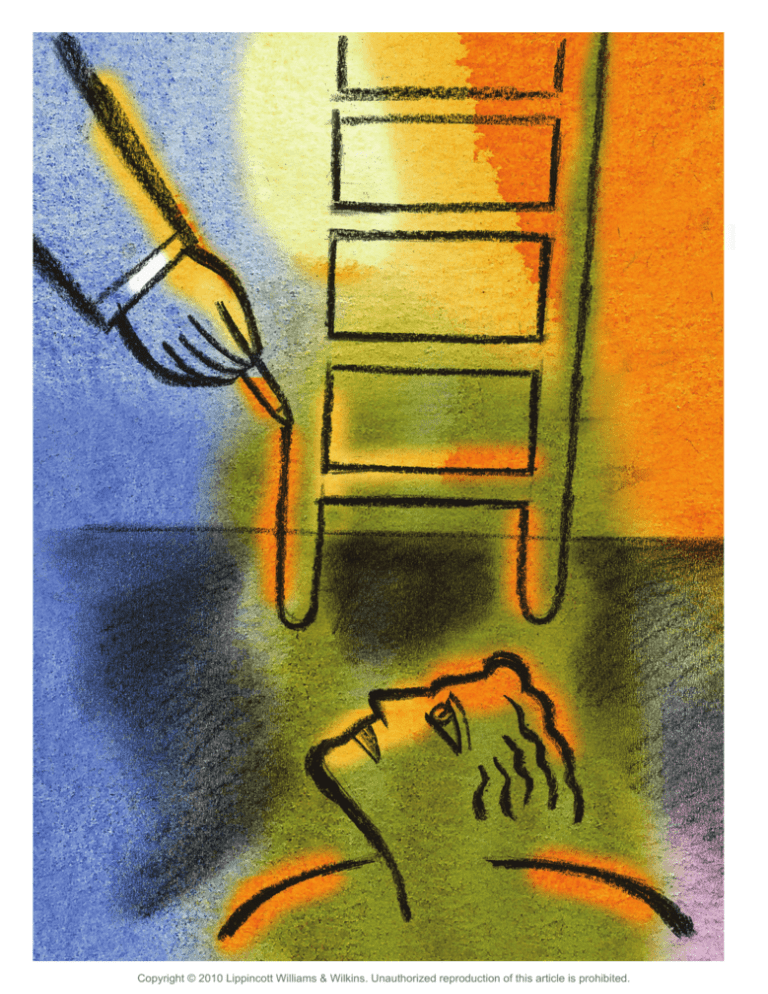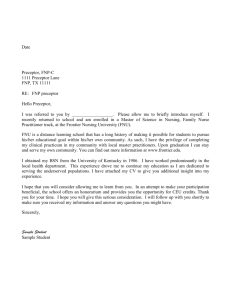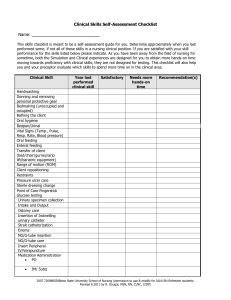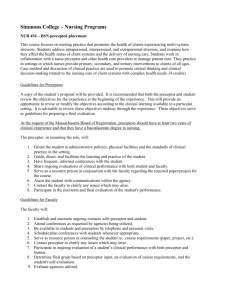Copyright © 2010 Lippincott Williams & Wilkins. Unauthorized
advertisement

40 November 2010 Nursing Management www.nursingmanagement.com Copyright © 2010 Lippincott Williams & Wilkins. Unauthorized reproduction of this article is prohibited. Staff development special: Preceptor pointers Try these educational techniques to create a current, memorable learning experience for new nurses and managers. By Alicia L. Culleiton, DNP, RN, CNE “I had such a great nursing preceptor!”Have you ever heard L e o n Ze r ni t s k y a graduate nurse (GN) make such a comment upon completing a critical care preceptored experience? Although such praise is commonplace, the ability to be an effective preceptor and teacher for GNs in critical care settings is a learned skill. As an effective preceptor, you should draw upon not only your own nursing expertise and wisdom, but also your understanding of the educational process. To gain the necessary teaching knowledge, you’ll need to know which assessment and instructional methods are available and how to use them in the clinical setting. The ability to generate effective learning experiences for GNs is crucial. A recent study reported that 13% of newly licensed RNs changed jobs after 1 year, and 37% intended to search for a new position in 1 year.1 A second study found that the average www.nursingmanagement.com Nursing Management November 2010 41 Copyright © 2010 Lippincott Williams & Wilkins. Unauthorized reproduction of this article is prohibited. Preceptor pointers voluntary turnover rate for firstyear nurses was 27.1%, and for nurses with 1 to 3 years of service, it was 28.1%. Given these statistics, you must provide opportunities for GNs to articulate their knowledge. As a critical care preceptor, you should engage the soon-to-be RN in activities that leave a lasting impression and foster critical thinking and collaborative skills. The emphasis on preceptoring or orienting GNs in the CCU must shift to developing and improving cognitive skills rather than simply developing technical and psychomotor skills. This article will focus on your role as a critical care preceptor, tice gaps that will be present as a GN transitions from the preceptored experience to independent practice in the critical care setting. From novice to expert The first step in preparing for a successful preceptored experience is to consider the “novice to expert” levels of capability. Patricia Benner used the model originally proposed by Dreyfus and described nurses as transitioning through five levels of proficiency: novice, advanced beginner, competent, proficient, and expert.4,5 Each level builds on the previous one as abstract principles are refined and expanded upon by practical experience and The first step in preparing for a successful preceptored experience is to consider the “novice to expert” levels of capability. explore adapted classroom assessment and instructional techniques you can use, and introduce an effective framework to address the needs of GNs. The nursing generalist Nursing programs focus on preparing and graduating well-educated nurse generalists who are prepared to pass the state board licensure examination. The National State Boards of Nursing tests GNs for the minimum level of safety and competency.3 But because of the high acuity of the critical care patient population, critical care preceptors must address the learning and prac- clinical expertise. Based on Benner’s work, “nurses new to practice are advanced beginners, applying textbook knowledge to clinical situations with rule-based perspectives, lacking the experience and judgment to exercise critical decision making.”6 As a preceptor, you’re encouraged to create a mental picture of what you believe represents an “expert critical care clinician,” understanding that this image is most certainly not the GN. This gap may appear to be an obvious conclusion, but by creating the ideal image, you’re challenged to alter your thought processes when inter- 42 November 2010 Nursing Management acting with the GN. In other words, you must actively “bring it down a notch,” and create realistic expectations based on the GN’s level of development. Your teaching plan also should foster the GN’s development of critical thinking skills while simultaneously providing for optimal patient care and safety. The advanced beginner will focus on mastering the routine of the CCU and the technical and task-oriented aspects of patient care that are easily applied to multiple patient populations. For example, consider this patient scenario: A 58-year-old woman is admitted to the medical ICU following a complicated abdominal cholecystectomy. The patient’s initial physical assessment is unremarkable, although she complains of mild abdominal pain (a 4 on a pain intensity rating scale of 0 [no pain] to 10 [worst pain imaginable]). She’s given I.V. morphine and is alert and oriented with stable vital signs (BP, 128/86 mm Hg; heart rate, 100 beats/minute; respirations, 20; and SpO2, 99% on room air). The cardiac monitor shows normal sinus rhythm; her abdominal dressing is clean, dry, and intact; she’s receiving I.V. 0.9% sodium chloride solution; and her nasogastric (NG) tube is secured and draining moderate amounts of yellowish-green fluid. One hour later, she begins to vomit large amounts of yellowishgreen fluid, her right lower abdominal dressing is now saturated with bloody drainage, and her vital signs are: BP, 100/60 mm Hg; heart rate, 140 beats/min; respirations, 26; and SpO2, 96% on room air. She’s restless, diaphoretic, and has pulled out her peripheral I.V. access. In this patient situation, the advanced beginner may concentrate on obtaining vital signs, www.nursingmanagement.com Copyright © 2010 Lippincott Williams & Wilkins. Unauthorized reproduction of this article is prohibited. assessing lung sounds, analyzing the patient’s rhythm strip, and recording intake and output. The advanced beginner is unable to see the patient and her situation in its entirety. The GN focuses on separate tasks and pieces of unrelated data, and places equal relevance on all data; the GN isn’t prepared to assimilate the information and respond as an expert clinician would. In comparison, if you, the expert, were caring for the same patient, you’d complete the same tasks as the GN, but wouldn’t get caught up in the technical aspects of care. Rather, you’d systematically gather data and use your nursing knowledge and experience to direct the patient’s care. You’d obtain and compare current vital signs with those recorded previously, as well as measure the patient’s abdominal girth. You’d recognize that although the dressing is now saturated, it should be left intact, reinforced, and the findings documented. Also, you’d realize that the patient’s vomiting with an NG tube in place is troublesome because the NG tube should be emptying her stomach. The vomiting suggests that the NG tube isn’t functioning properly, so you’d troubleshoot for possible problems. Finally, you’d conclude that the patient’s vital signs may be consistent with shock, and until it’s determined she’s not experiencing a shock state, you’d continually monitor her level of consciousness, vital signs, and urine output, and would notify the surgeon immediately. In this scenario, you’re able to zero in on the patient’s problems, and your performance becomes fluid, flexible, and highly proficient.5 To help GNs transition from novice to expert, continually encourage them to try to make www.nursingmanagement.com connections between their learning experiences. They should watch for recurring themes, draw upon concrete experiences, and share their insights with you so the experiences can be further expanded and built upon. This approach is effective because it encourages the GN to begin to acquire a strong technical foundation in conjunction with critical thinking abilities. As a result, the GN will be able to process the unique clinical findings of individual patients, and intervene appropriately. Assessment techniques Several classroom assessment techniques can be used by preceptors to improve the quality of learning. One of these techniques, the “muddiest point,” gives you short-term feedback about the GN’s daily learning, while allowing sufficient time for you to address any concerns.7 In the classroom setting, muddiest point activities are used to identify what students find least clear or most confusing about a particular topic. These activities tell educators what content their students find most difficult to learn; educators can then adjust their teaching strategies to focus more intently on those issues. Commonly, the muddiest point activity is completed at the end of class. The students are asked to write a quick response to a question such as, “What is the muddiest point in today’s lecture?” The educator then collects the comments and responds to the students’ feedback during the next class session. In the clinical setting, the use of the muddiest point doesn’t have to be as formal as in the classroom setting (providing written responses) and can be used at a variety of points throughout the nursing shift. Elicit the GN’s feedback by asking what was the muddiest point in the procedure or activity. For example, ask for feedback after shift report, before and after the explanation and completion of a new procedure, after receiving report for a patient being admitted to the unit, and as a reflection activity at the end of the nursing shift. The answers to the muddiest point questions will vary greatly, but the use of the muddiest point activity encourages GNs to rapidly assess what they don’t understand and then attempt to articulate their confusion to the preceptor. By obtaining speedy feedback on areas where the GN is struggling, you can decide what to emphasize, clarify misconceptions, stimulate teachable moments, help guide or redirect the GN’s actions, and provide an overall idea of how much time to spend on certain topics as themes related to “muddy” topics emerge. Using a performance-based system Another instructional technique you can use is based on the Performance Based Development System (PBDS) assessment. This customized computer-based competency assessment tool is used by hospitals to assess GNs’ critical thinking, interpersonal, and technical skills.8 One aspect of the PBDS uses videotaped patient vignettes to assess GNs’ ability to correctly identify specific patient events and situations that are an imminent threat to patient stability or safety.9 The more complicated vignettes of the PBDS assessment depict situations in which the patient’s condition is deteriorating. When responding to these scenarios, clinicians set priorities based on what they must do, should do, and could do.8 Additionally, clinicians Nursing Management November 2010 43 Copyright © 2010 Lippincott Williams & Wilkins. Unauthorized reproduction of this article is prohibited. Preceptor pointers are expected to list and identify the patient’s main problem (for example, acute myocardial infarction), assessment findings, nursing interventions with rationales, what data to report to the healthcare provider, anticipated orders, and any miscellaneous data that the clinician may consider important, such as lab test results or medications.9 The PBDS assessment concepts can be used to greatly enhance the effectiveness of the preceptor experience. You can implement the underlying concepts during an actual patient situation to assess your GN’s prioritization and critical thinking skills. This process will This activity ensures ongoing communication between you and the GN, and gives you an opportunity to validate the GN’s plan of action. You can also guide the GN to formulate or clarify a priority list by asking: • “Do you need to implement that nursing intervention immediately, or can it wait?” • “What’s essential for you to complete?” • “Do you need to complete that activity, or can you appropriately delegate it to another member of the healthcare team?” Because a critically ill patient’s status can change quickly, you’ll also need to assess the GN’s ability Don’t get caught up in the “parrot pitfall”—simply requiring the GN to parrot back information that’s easily memorized. help prepare the GN for the PBDS assessment itself, if the facility requires it. When implementing the PBDS activity, you may find it helpful to have the GN complete a “must do, should do, could do” activity after shift report. Explain that: • “must do” activities must be accomplished during the initial 30 minutes of the shift • “should do” activities should be accomplished within the first 4 hours of the shift • “could do” activities could be completed after the higher-priority activities are accomplished and before the end of the shift.10 to deviate from or modify the original priority list and formulate a new set of priorities based on the patient’s clinical status. In essence, you’re helping to prepare the GN to “rescue” patients before a “failure to rescue” situation presents itself. The term failure to rescue is defined as a clinician’s inability to save a hospitalized patient’s life when the patient experiences a complication.11 You’re responsible for supervising, guiding, and supporting the GN during a change in a patient’s status or a patient emergency, and nurturing the GN’s instinctual sense of urgency to act. 44 November 2010 Nursing Management For example, suppose a patient in the CCU is receiving mechanical ventilation and the ventilator alarms begin to sound. You ask the GN, “In order of priority, what are you going to do in response to the alarms?” In the best-case scenario, the GN would respond, “Go to the patient’s bedside and quickly check for possible causes of the alarm that can be fixed, manually ventilate the patient while waiting for the respiratory therapist, then reconnect the ventilator and reassess the patient’s status.” Following this situation, and any other potential patient crisis, you and the GN should review your interventions to identify the outcomes of the GN’s actions and to identify the GN’s strengths and weaknesses. Avoiding the parrot pitfall Preceptors of GNs can easily get caught up in the “parrot pitfall”— simply requiring the GN to parrot back information that’s easily memorized, such as definitions or normal values. This level of cognitive ability is referred to as the remember level, the simplest level in Benjamin S. Bloom’s taxonomy.12,13 But nursing practice requires application of knowledge, skills, and abilities.3 So you should attempt to question the GN at the higher levels of cognitive ability that require the GN to use a more advanced thought process. In Bloom’s taxonomy, categories are remember, understand, apply, analyze, evaluate, and create.13 Nursing educators commonly use this taxonomy to develop course objectives and examination questions. Listed below are the skills a learner demonstrates at each level: • Remember: The ability to memorize and recall specific information such as terms, facts, and principles www.nursingmanagement.com Copyright © 2010 Lippincott Williams & Wilkins. Unauthorized reproduction of this article is prohibited. • Understand: The ability to interpret information and translate it into one’s own words and translate information from one situation to another • Apply: The ability to apply knowledge to a clinical scenario, the use of problem-solving skills, and the use of information in a context different from the one in which it was learned • Analyze: The ability to subdivide information and specify the relationship between parts, analyze relationships between information, and then use the knowledge of those relationships to solve a problem • Evaluate: The ability to make value decisions about issues or situations by applying standards or criteria • Create: The ability to combine pieces and elements into a unified whole, creating something new based on past experiences.12,13 When interacting with the GN, you should use appropriate questioning techniques based on the GN’s different cognitive levels. Try these action verbs and follow the example questions for the different cognitive levels: • Remember (define, label, list, identify, name): “Can you list three potential causes of tachycardia?” or “What causes tachycardia?” • Understand (classify, demonstrate, explain, restate, summarize): “Can you explain why neuromuscular blocking agents are used in the management of some mechanically ventilated patients?” or “Give an example of when a neuromuscular agent may be administered to a mechanically ventilated patient?” • Apply (apply, judge, organize, solve, use): “How would you judge if the medication produced the desired effects?” or “Can you predict what would happen to the patient if the medication wasn’t administered?” www.nursingmanagement.com • Analyze (analyze, classify, compare, differentiate, infer): “Are you able to differentiate right-sided heart failure from left-sided heart failure?” or “What justifies your conclusion that the patient is experiencing left-sided heart failure?” • Evaluate (appraise, criticize, defend, prioritize, recommend): “What would you recommend to the healthcare provider based on the patient’s lab results?” or “What would the consequences be of not addressing the patient’s hyperkalemia?” • Create (create, construct, develop, formulate, produce): “Can you formulate a plan of care for the patient based on the assessment findings?” or “Can you propose an alternative plan of care for the patient based on the assessment findings?” Becoming familiar with these verbs lets you develop higher-level questions for the GN as the preceptored experience advances. An additional benefit to using this questioning format is that it will prepare the GN for the licensure examination, which primarily tests at the application level and higher.3 Keeping education current The nursing preceptor is often considered an expert clinician, but an effective nursing preceptor should also be considered a nurse educator. As you approach your role as a preceptor, remember that clinical education is continuously adapted to meet the needs of beginning clinicians and to advance current and future nursing practice. By trying alternative assessment and instructional techniques like those described above, you can be an effective preceptor and ensure that clinical education remains current, evolving, and innovative in the dynamic and complex critical care setting. NM REFERENCES 1. Kovner CT, Brewer CS, Fairchild S, Poornima S, Kim H, Djukic M. Newly licensed RNs’ characteristics, work attitudes, and intentions to work. Am J Nurs. 2007;107(9):58-70. 2. PricewaterhouseCoopers’ Health Research Institution. What works: healing the healthcare staffing shortage. PricewaterhouseCoopers’(United States). http://www.pwc.com/us/en/ healthcare/publications/what-workshealing-the-healthcare-staffingshortage.jhtml. 3. National Council of State Boards of Nursing. Test plan for the national council licensure examination for registered nurses. https://www.ncsbn.org/ RN_Test_Plan_2007_Web.pdf. 4. Benner P. From Novice to Expert: Excellence and Power in Clinical Nursing Practice. Commemorative edition. Upper Saddle River, NJ: Prentice Hall Health; 2001. 5. Benner P. Using the Dreyfus Model of skill acquisition to describe and interpret skill acquisition and clinical judgment in nursing practice and education. Bull Sci Technol Soc. 2004;24:188-199. 6. Krugman M, Bretschneider J, Horn PB, et al. The national post-baccalaureate graduate nurse residency program: a model for excellence in transition to practice. J Nurses Staff Dev. 2006; 22(4):196-205. 7. Angelo TA, Cross KP. Classroom Assessment Techniques: A Handbook for College Teachers. 2nd ed. San Francisco, CA: Jossey-Bass; 1993. 8. Performance Management Services Inc. http://www.pmsi-pbds.com. 9. Del Bueno D. A crisis in critical thinking. Nurs Educ Perspect. 2005;26(5):278-282. 10. Anthony CE, Del Bueno D. A performancebased development system. Nurs Manage. 1993;24(6):32-34. 11. Clarke SP, Aiken LH. Failure to rescue. Am J Nurs. 2003;103(1):42-47. 12. Bloom BS, Engelhart MD, Furst EJ, et al. Taxonomy of Educational Objectives: The Classification of Educational Goals. Handbook 1: Cognitive Domain. New York, NY: David McKay; 1959. 13. Krathwohl DR. A revision of Bloom’s Taxonomy: an overview. Theory Into Practice. 2002;41(4):212-218. Alicia L. Culleiton is an assistant clinical professor at Duquesne University School of Nursing in Pittsburgh, Pa. DOI-10.1097/01.NUMA.0000389014.28740.18 Nursing Management November 2010 45 Copyright © 2010 Lippincott Williams & Wilkins. Unauthorized reproduction of this article is prohibited.






